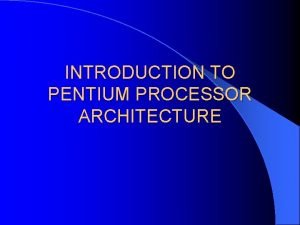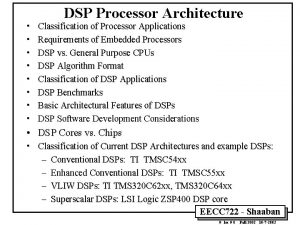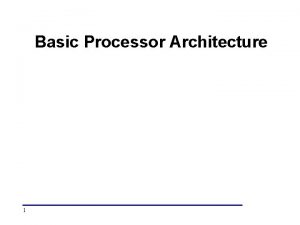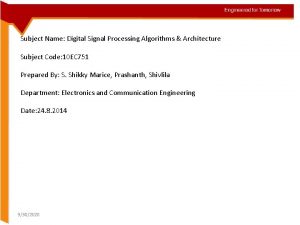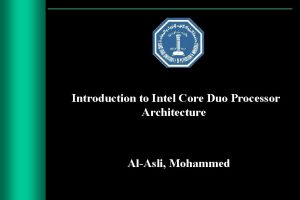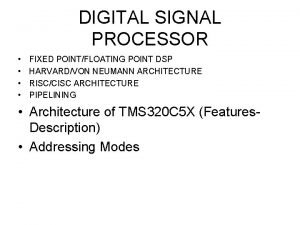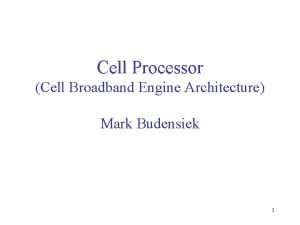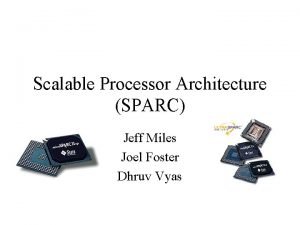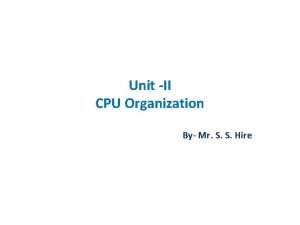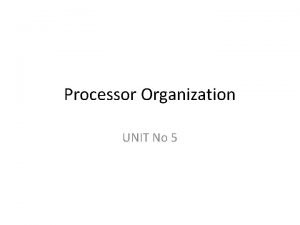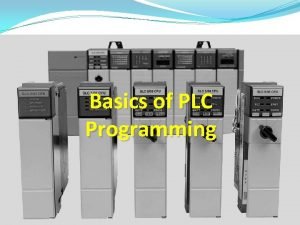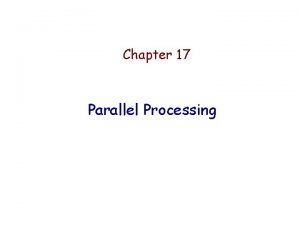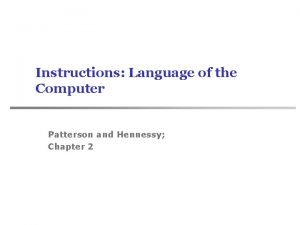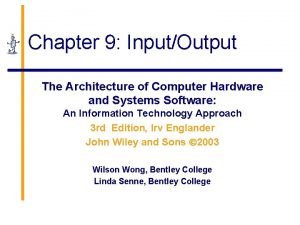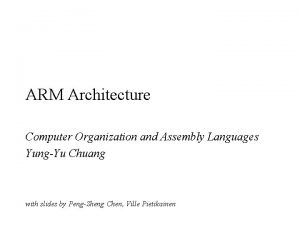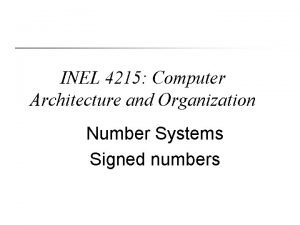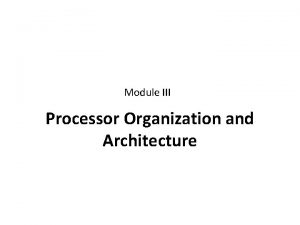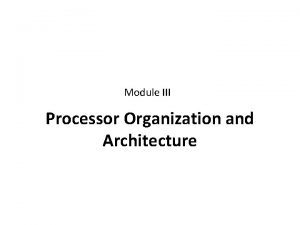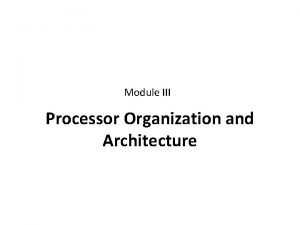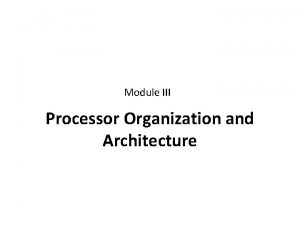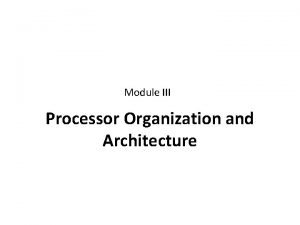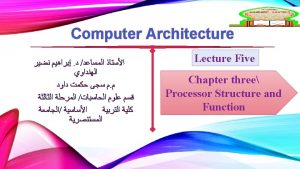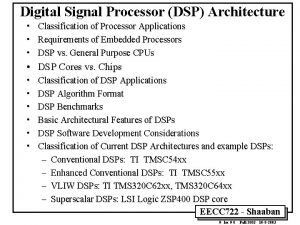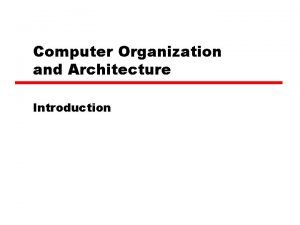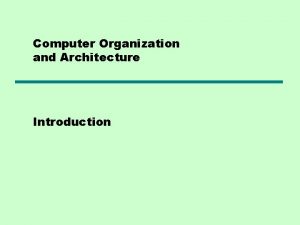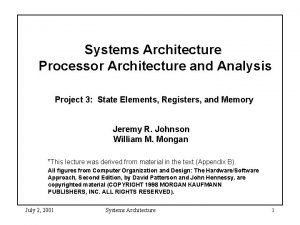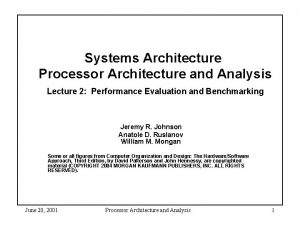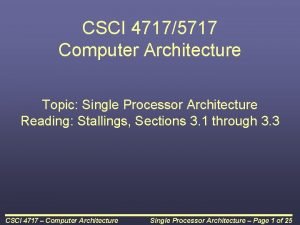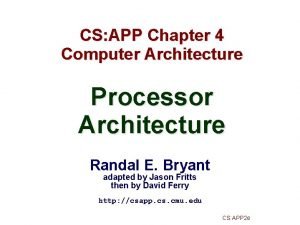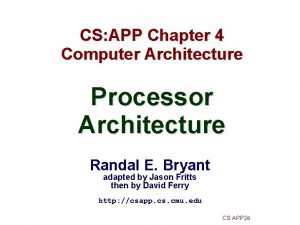Module III Processor Organization and Architecture Processor Organization






























- Slides: 30

Module III Processor Organization and Architecture

Processor Organization • Requirements of CPU: 1. 2. 3. 4. Fetch instructions (from m/m, reg, cache) Interpret instructions (decoding) Fetch data Process data/Execute (arithmetic/logical operations) 5. Write data

Processor Organization • It connects rest of system via system bus • The major components of processor are – ALU does processing – CU controls movement of data and ALU – Registers (Internal Memory consisting of a set of storage locations)

Internal Structure of CPU

Internal Structure of CPU • It includes data transfer (between registers and ALU) and logic control paths. • It also includes an internal CPU bus to transfer data between ALU and Registers

Register Organization • The registers in the processor performs two roles: 1. User Visible Registers : – Minimize main memory references by optimizing use of registers 2. Control and Status Registers: – Used by control unit to control the operation of processor

User Visible Registers • Referenced by means of machine language • They are categorized as : – General Purpose – Data – Address – Condition Codes

General Purpose Registers • Contain operands • Can be used for addressing functions Data Registers • Used only to hold data

Address Registers • may be general purpose or • devoted to an addressing mode – Example: • Segment Pointers: holds base address of segment • Index Registers: for indexed addressing • Stack Pointer: points to the top of stack.

Condition Codes (Flags) • Bits set by the processor hardware as the result of operations • E. g. Carry, Overflow, Sign • They may be tested as part of conditional branch operation • Condition code bits are collected into one or more registers but the programmer cannot alter them.

Design Issues with Registers • Whether to use general purpose or specialized registers: – Specialized Register : Operand is specified implicit • E. g. PUSH and POP in Stack – Specialization limits programmer’s flexibility • No. of registers to be provided – More registers requires more operand specifier bits – Fewer will result in more memory references.

Design Issues with Registers • Issue of Register Length – Must be long enough to hold • the largest address and • most of the data types

Control and Status Registers • Control Registers : Four registers essential for instruction execution are – Program Counter – Instruction Register – Memory Address Register – Memory Buffer Register

Status Register • A register or set of registers that contain status information is called Program Status Word (PSW) • PSW contains condition codes and other status information • PSW contains : – Sign: Sign bit of last operation – Zero: Set when result is 0. – Carry: Set when a carry/borrow is generated /taken.

Status Register • PSW contains : – Overflow: When arithmetic overflow occurs – Interrupt Enable/Disable: Used to enable / disable interrupts – Supervisor: Indicates whether in supervisor/user mode. • Other registers are : interrupt vector register, system stack pointer

Addressing Modes • How to specify operands • The different modes are: – Immediate – Direct – Indirect – Register Indirect – Displacement (Indexed) – Stack

Immediate Addressing • Operand is part of instruction • e. g. ADD 5 – Add 5 to contents of accumulator – 5 is operand • Adv: – No memory reference to fetch data – Fast • Disadv: – Limited range

Immediate Addressing Instruction Opcode Operand

Direct Addressing • Address field contains effective address of operand • e. g. ADD A – Look in memory at address A for operand • Adv: – Single memory reference to access data – No additional calculations to work out effective address • Disadv: Limited address space

Direct Addressing Instruction Opcode Address A Memory Operand

Indirect Addressing • Memory cell pointed to by address field contains the address of (pointer to) the operand • EA = (A) – Look in A, find address (A) and look there for operand • e. g. ADD (A) – Add contents of cell pointed to by contents of A to accumulator

Indirect Addressing Instruction Opcode Address A Memory Pointer to operand Operand

Indirect Addressing • Adv: – Large address space – 2 n where n = word length – May be nested, multilevel, cascaded • e. g. EA = (((A))) • Disadv: Multiple memory accesses to find operand hence slower

Register Addressing • Address field refers to a register • EA = R • Adv: – Only a small address field is needed in the instruction – Less access time • Disadv: – Limited number of registers – Limited address space

Register Addressing Instruction Opcode Register Address R Registers Operand

Register Indirect Addressing • Similar to indirect addressing • EA = (R) • Operand is in memory cell pointed to by contents of register R • One fewer memory access than indirect addressing

Register Indirect Addressing Instruction Opcode Register Address R Memory Registers Pointer to Operand

Displacement Addressing • Combines direct and register indirect addressing • EA = A + (R) • Address field hold two values – A = base value – R = register that holds displacement – or vice versa

Displacement Addressing Instruction Opcode Register R Address A Memory Registers Pointer to Operand + Operand

Stack Addressing • Stack is a reserved block of locations • Stack pointer holds the address of the top of the stack. • It is a form of implied addressing: as no memory reference is required but operate on the top of the stack
 Hamlet act iii scene iii
Hamlet act iii scene iii C device module module 1
C device module module 1 Intel pentium processor architecture
Intel pentium processor architecture Xxeecc
Xxeecc Basic processor architecture
Basic processor architecture Dsp algorithms and architecture notes
Dsp algorithms and architecture notes Intel core processor architecture
Intel core processor architecture Risc
Risc Cell processor architecture
Cell processor architecture Scalable processor architecture
Scalable processor architecture Perceptual constancy
Perceptual constancy Module 19 visual organization and interpretation
Module 19 visual organization and interpretation Processor organization
Processor organization Data flow, fetch cycle
Data flow, fetch cycle Pentium 4 cache organization
Pentium 4 cache organization The memory organization of a plc is often called
The memory organization of a plc is often called Organisasi komputer
Organisasi komputer Processor organization
Processor organization Tos example for elementary
Tos example for elementary Usb chapter 9
Usb chapter 9 Return architecture
Return architecture Computer organization and architecture 10th solution
Computer organization and architecture 10th solution Computer architecture lab experiments
Computer architecture lab experiments Introduction to computer organization and architecture
Introduction to computer organization and architecture Computer organization & architecture: themes and variations
Computer organization & architecture: themes and variations Diff between computer architecture and organization
Diff between computer architecture and organization Computer organization and architecture 10th edition
Computer organization and architecture 10th edition Arm architecture and organization
Arm architecture and organization Computer organization and architecture stallings
Computer organization and architecture stallings Computer organisation and architecture
Computer organisation and architecture 1s complement
1s complement


